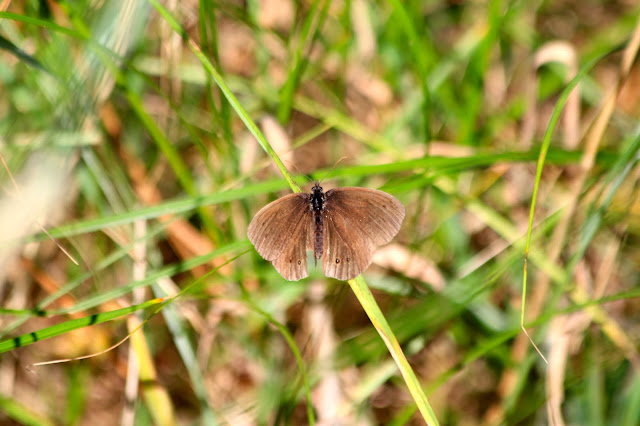At the edge of our local woods lies a very special little
place. It is a place that is probably overlooked by many, but those who take
time to notice it will understand why it holds a place in my heart.
The woods are separated from the agricultural fields beyond by
two rows of overgrown thickets of brambles, stinging nettles and young ash
trees. But between these tangles of vegetation winds a trodden down grassy
path, just over a metre in width. In the past couple of months we have found
that this clearing provides an incredible habitat for butterflies. So far we
have seen Small Skippers, Meadow Browns, Ringlets, Small Whites and Gatekeepers.
 |
| Small White |
Lazy hazy summer afternoons spent watching the butterflies’
graceful gravity-defying dynamism are magical. The rarity with which you come
across another human in the clearing gives the place a tranquil feeling of
detachment from the hustle and bustle of modern life. As you wander along the
path, with innumerable glistening butterflies gliding just inches from you, you
could believe that you had been transported into a fairy tale world.
 |
| Meadow Brown |
Through watching the butterflies in our patch, I have
noticed the fascinating differences in their behaviour. The Small Whites float
elegantly between flowers, stopping for some time to feed and warm themselves
but the Small Skippers are much faster, only resting briefly and energetically
darting throughout the undergrowth. Even only considering those butterflies we
have seen in the clearing, there is such a striking variety of colours and
patterns to behold, which makes watching them such a joy.
 |
| Meadow Brown |
While it is wonderful to appreciate the pure beauty of these
incredible creatures, it is important to remember that they exist in a
delicately balanced ecosystem and are threatened by changes in the management
of their habitats. Areas such as this, where butterflies are so abundant, can
teach us a great deal about the best ways to create valuable environments which
allow them to live and reproduce.
 |
| Small Skipper |
Many people are aware that certain plants attract
butterflies because they provide rich nectar sources, but for butterflies to thrive
in an area it is also important that there are sources of food for caterpillars
and the right settings for pupation. Different butterflies need different
conditions to thrive, which is partly why you will notice that certain areas
are abundant with a few species of butterflies, but void of others. Often
butterflies are very specialist feeders so in the absence of the flowers that
they need to feed, they won’t adapt, they just will not survive. Therefore, the
places where multiple butterfly species thrive will contain a range of grasses,
shrubs and plants, such as thistles, stinging nettles, nasturtiums, willows and
sallows, for caterpillars, and various flowering plants, such as buddleia,
marigolds, lavender and dandelions, for adult butterflies.
 |
| Gatekeeper |
The clearing at the edge of our woods has been managed in a
natural way which has allowed wildflowers to thrive. If these plants arrive in
people’s gardens, they are usually seen as ‘weeds’ and torn out, but
butterflies love them so it would be brilliant if people could at least leave a
small section of their garden where they are allowed to grow and bloom. We have
turned our small front garden into a mini wildflower patch and planted
butterfly friendly plants in the borders of our back garden, and noticed an instant
boom in the number of butterflies visiting.
 |
| Ringlet |
The clearing is teeming with flowering plants such as
Rosebay Willowherb (Chamerion angustifolium), Common Ragwort (Senecio jacobaea), Viper’s Bugloss (Echium vulgare), blackberry bushes (Rubus fruticosus) and
Creeping Thistle (Cirsium arvense). Without this variety of herbage the butterflies would not
show this place so much love.
 |
| Small White |
Important, also, is the structure of the clearing.
Butterflies, as all insects, cannot regulate their body temperature and,
therefore, need the sunlight’s warmth to heat them up before they forage. For
the butterflies that we regularly see in the clearing, dense woodland would not
provide enough access to sunlight to allow them to thrive and, therefore, the
clearing offers a welcome sun-trap amongst the dark thickets of trees. It also
goes without saying that many of the plants that the butterflies need to
succeed rely on good sources of sunlight in order to grow. The fact that the
clearing is flanked on both sides by tangles of overgrown foliage and small
trees also means that the butterflies have a calm area in which to fly, protected
from the wind.
 |
| Meadow Brown |
Since we discovered the clearing I have been having a great
time commandeering Andrew’s camera and eagerly taking photos of these beautiful
insects. I have found it so much fun to capture the butterflies on camera that
I have set myself a challenge. I’m going to photograph every British butterfly
species!
 |
| Gatekeeper |
Seeing as every butterfly is only around for a certain
period each year, this will likely take years to complete. While the likes of
Meadow Browns practically offer themselves to be photographed, I think I’m
going to have more of a trial ahead trying to locate butterflies which are
found only in a small area, such as the Lulworth Skipper and the Mountain Ringlet,
or in difficult to see positions, such as the Purple Emperor which mainly flies
around tree canopies. Each time I photograph a new species I’m going to post it
on the blog to keep you updated. For this article I’ve just embedded the photos
throughout the text but here is my list so far:
Local woods
Gatekeeper
Meadow Brown
Ringlet
Small White
Small Skipper
I’ve started with a few of the most common, so wish me luck
for the more difficult ones ahead – I can’t wait for the challenge!
 |
| Small Skipper |

No comments:
Post a Comment